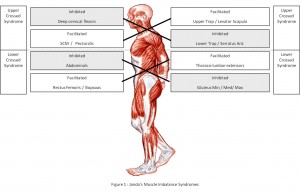Janda Syndromes
Over time, these imbalances will spread throughout the muscular system in a predictable manner. Janda has classified these patterns as “Upper Crossed Syndrome” (UCS), “Lower Crossed Syndrome” (LCS), and “Layer Syndrome” (LS) (Janda, 1987, 1988). [UCS is also known as “cervical crossed syndrome”; LCS is also known as “pelvic crossed syndrome; and LS is also known as “stratification syndrome.”] Crossed syndromes are characterized by alternating sides of inhibition and facilitation in the upper quarter and lower quarter. Layer syndrome, essentially a combination of UCS and LCS is characterized by alternating patterns of tightness and weakness, indicating long-standing muscle imbalance pathology. Janda’s syndromes are summarized in Figure 1.

Upper crossed syndrome is characterized by facilitation of the upper trapezius, levator, sternocleidomastoid, and pectoralis muscles, as well as inhibition of the deep cervical flexors, lower trapezius, and serratus anterior. Lower crossed syndrome is characterized by facilitation of the thoraco-lumbar extensors, rectus femoris, and iliopsoas, as well as inhibition of the abdominals (particularly transversus abdominus) and the gluteal muscles.
By using Janda’s classification, clinicians can begin to predict patterns of tightness and weakness in the sensorimotor system’s attempt to reach homeostasis. Janda noted that these changes in muscular tone create a muscle imbalance, which leads to movement dysfunction. Muscles prone to tightness generally have a “lowered irritability threshold” and are readily activated with any movement, thus creating abnormal movement patterns. These imbalances and movement dysfunctions may have direct effect on joint surfaces, thus potentially leading to joint degeneration. In some cases, joint degeneration may be a direct source of pain, but the actual cause of pain is often secondary to muscle imbalance. Therefore, clinicians should find and treat the cause of the pain rather than focus on the source of the pain.
Janda Evaluation
Janda Treatment
1. Normalize the periphery. The Janda approach to treatment of musculoskeletal pain follows several steps. Treatment of muscle imbalance and movement impairment begins with normalizing afferent information entering the sensorimotor system. This includes providing an optimal environment for healing (by reducing effusion and protection of healing tissues, restoring proper postural alignment (through postural and ergonomic education), and correcting the biomechanics of a peripheral joint (through manual therapy techniques).
2. Restore Muscle Balance. Once peripheral structures are normalized, muscle balance is restored. Normal muscle tone surrounding joints must be restored. Sherrington’s law of reciprocal inhibition (Sherrington, 1907) states that a hypertonic antagonist muscle may be reflexively inhibiting their agonist. Therefore, in the presence of tight and/or short antagonistic muscles, restoring normal muscle tone and/or length must first be addressed before attempting to strengthen a weakened or inhibited muscle. Techniques to decrease tone must be specific to the cause of the hypertonicity. These include post-isometric relaxation (PIR) (Lewit, 1994) and post-facilitation stretch (PFS) (Janda, 1988).
Muscles that have been reflexively inhibited by tight antagonists often recover spontaneously after addressing the tightness. In the Janda approach, the coordinated firing patterns of muscle are more important than the absolute strength of muscles. The strongest muscle is not functional if it cannot contract quickly and in coordination with other muscles; therefore, isolated muscle strengthening is not emphasized in the Janda approach. Instead, muscles are facilitated to contract at the proper time during coordinated movement patterns to provide reflexive joint stabilization.
3. Increase afferent input to facilitate reflexive stabilization. Once muscle balance has been addressed, Janda stresses increasing proprioceptive input into the CNS with a specific exercise program, “Sensorimotor Training” (SMT) (Janda & Vavrova, 1996). This program increases afferent information entering the subcortical pathways (including spinocerebellar, spinothalamic, and vestibulocerebellar pathways) to facilitate automatic coordinated movements. SMT involves progressive stimulation through specific exercises with increasing level of challenge to the sensorimotor system. SMT has been proven to improve proprioception, strength, and postural stability in ankle instability (Freeman et al. 1965), knee instability (Ihara & Nakayam, 1996), and after ACL reconstruction (Pavlu & Novosadova, 2001).
4. Increase endurance in coordinated movement patterns. Finally, endurance is increased through repetitive, coordinated movement patterns. Since fatigue is a predisposing factor to compensated movement patterns, endurance is also more important than absolute strength. Exercises are performed at low intensities and high volumes to simulate activities of daily living.
The Janda approach is valuable in today’s managed care environment. Once these patterns and syndromes are identified, specific treatment can be implemented without expensive equipment. Early detection of these causes of chronic pain allows the clinician to treat the patient with fewer visits and less expensive equipment compared to traditional interventions that emphasize modalities and passive treatments. The key to the Janda approach is in the home exercise program. Inexpensive home exercise equipment such as wobble boards, elastic bands, and foam pads are used with a specific progression of exercises as the patient improves in function.
Summary
In summary, the Janda approach emphasizes the importance of the CNS in the sensorimotor system, and its role in the pathogenesis in musculoskeletal pain. In particular: the neurological pre-disposition of muscles to exhibit predictable changes in tone, and the importance of proprioception and afferent information in the regulation of muscle tone and movement. Therefore, assessment and treatment focus on the sensorimotor system, rather than the musculoskeletal system itself. Using a functional, rather than a structural approach, the cause of musculoskeletal pain can be quickly identified and addressed. The Janda approach can be a valuable tool for the clinician in the evaluation and treatment of chronic musculoskeletal pain.

